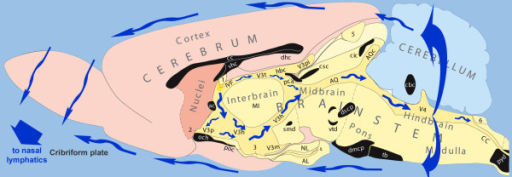cerebral spinal fluid phosphatidylcholine
is another fancy term for CSF lecithin.
Turns out all sorts of diseases are from the improper regulation of lecithin in the body - the LACK of it in the CSF - or maybe too much?Recent animal investigations, however, have shown that at least 50% and perhaps up to 80% or more of the CSF leaves the cranial cavity through the cribriform plate, via the perineuronal spaces surrounding the olfactory nerves, to drain into the nasal and cervical lymphatics (Fig 2) [64-70]. This rostral outflow of CSF contains considerable amounts of interstitial fluid, especially from midbrain areas [71,72], and plays an important role in CNS immune system interactions [68,73].
It needs to be recycling and ionized via the pineal gland and the lower tan t'ien (small intestines)....
When the hamsters were maintained in a short photoperiod (LD 8:16), the CSF-contacting area of the pineal recess was significantly larger in those hamsters killed 2 hours before lights off compared to those killed 2 hours before lights on (P less than 0.01). There were no significant differences in the CSF-contacting area when comparing two groups of hamsters maintained in a long photoperiod (LD 14:10, killed 2 hours before lights on and lights off, respectively). There was statistically significant interaction (P less than 0.05) between the lighting cycle and the time of day of death on the appearance of CSF-contacting pinealocytes. The hamsters maintained in LD 8:16 had significantly reduced testicular weights when compared to those maintained in LD 14:10. The plasticity of the central zone and the associated CSF-contacting pinealocytes of the pineal recess of the hamster are evidence that this region demonstrates morphological changes that are dependent upon the physiological state of the animal.https://www.ncbi.nlm.nih.gov/pubmed/2600761
So science recognizes this natural "cycle" between light and the pineal gland and the testicles in animals - and also how the CSF flows out of the nasal cavity in animals!!
But I guess it's NOT supposed to happen in human? What's wrong with us?! Left Brain dominance has shut off our natural cycling of CSF lecithin.
The CSF has cholesterol ester synthesizing activity even though it has a lower lecithin amount than blood serum - the cerebrospinal fluid is able to access more lecithin in the brain.
That's from 1970 research. Now look at the current research.
Phosphatidylcholine AKA LECITHIN
The levels of circulating lecithin (phosphatidyl-choline) were depressed in a similar fashion to the levels of CRH in CSF [CerebroSpinal Fluid] in the SDAT patients and the group of severe dementia.
by P Miketova - 2005 - Cited by 57 - Related articles
We hypothesize that oxidation may lead to changed concentrations of choline containing phospholipids [lecithin] in cerebrospinal fluid (CSF) of AD patients,Biol Res Nurs. 2005 Jan;6(3):187-95. Oxidative changes in cerebral spinal fluid phosphatidylcholine [lecithin] during treatment for acute lymphoblastic leukemia.
Vagal afferent activation induces salivation and swallowing-like events ...
by H Ueda - 2016 - Related articles
Oct 5, 2016 - Vagal afferent activation induces salivation and swallowing-like events in ... salivation and increased the activity of the vagal afferent nerve.
Activation of Phosphatidylcholine Cycle Enzymes in Human Epithelial ...
cancerres.aacrjournals.org/content/70/5/2126
by E Iorio - 2010 - Cited by 142 - Related articles
Mar 1, 2010 - Altered phosphatidylcholine (PC) metabolism in epithelial ovarian cancer (EOC) could provide choline-based imaging approaches as powerful ...
It is through the epithelial cells - activated by the vagus nerve.
https://www.ncbi.nlm.nih.gov/pubmed/25433161
So about 80% of CSF proteins are from the blood and the CSF concentration outside the pineal gland is 100 times greater than the blood and 10 times greater than the rest of the brain! Pretty amazing.Phosphatidylethanolamine N-methyltransferase (PEMT), a liver enriched enzyme, is responsible for approximately one third of hepatic phosphatidylcholine [lecithin] biosynthesis. When fed a high-fat diet (HFD), Pemt(-/-) mice are protected from HF-induced obesity; however, they develop steatohepatitis. The vagus nerve relays signals between liver and brain that regulate peripheral adiposity and pancreas function. Here we explore a possible role of the hepatic branch of the vagus nerve in the development of diet induced obesity and steatohepatitis in Pemt(-/-) mice.


No comments:
Post a Comment